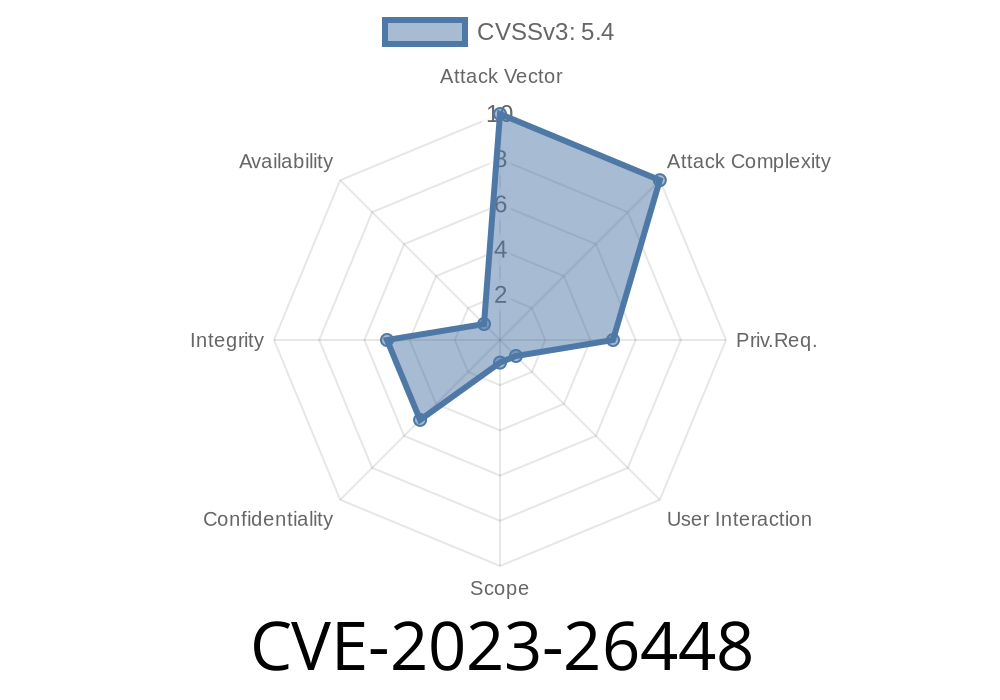CVE-2023-26448 is a vulnerability discovered in web applications that utilize custom log-in and log-out locations defined through the JavaScript Object Blob (jslob) system. This issue arises from the lack of proper sanitization of user-defined jslob content, potentially allowing for malicious protocol handlers and script code to be executed within the victim's context. If exploited, an attacker could hijack user sessions and trigger unanticipated actions via the web interface and the API of the affected application. Although there are no known publicly available exploits as of now, it's crucial to address this vulnerability to protect against potential attacks.
Exploit Details
In this vulnerability, malicious script code can be executed within the victim's context due to inadequate jslob content sanitization for custom log-in and log-out locations. This can lead to unwanted consequences such as session hijacking and the triggering of unintended actions using the web interface and API. To exploit this vulnerability, an attacker would need temporary access to the user's account or lure a user to a compromised account.
Here's an example code snippet illustrating the issue
// Define custom log-in and log-out location as user-defined jslob content
var loginLocation = 'https://example.com/login';;
var logoutLocation = 'https://example.com/logout';;
// jslob content not checked for malicious protocol handlers; can inject script code
jslob.set({
loginLoc: loginLocation,
logoutLoc: logoutLocation
});
// Malicious script code executed within the victim's context
window.location.href = jslob.get('loginLoc'); // Redirection to a malicious content
Mitigation Approach
To mitigate this vulnerability, it's necessary to sanitize jslob content for custom log-in and log-out locations to prevent redirects to malicious content. One possible solution is to use Content Security Policy (CSP) to limit the origins that can be navigated to by the application. Additionally, ensure that user input is validated and sanitized before being further processed.
Here's an example code snippet to sanitize jslob content in custom log-in and log-out locations
// Define custom log-in and log-out location as user-defined jslob content
var sanitizedLoginLocation = sanitize(jslob.get('loginLoc'));
var sanitizedLogoutLocation = sanitize(jslob.get('logoutLoc'));
// Sanitize function to avoid redirects to malicious content
function sanitize(url) {
// Validate and sanitize the URL to prevent malicious redirects
// Further logic to ensure safe redirection based on project requirements
return url;
}
// Now the custom log-in and log-out locations should only redirect to safe URLs
window.location.href = sanitizedLoginLocation;
window.location.href = sanitizedLogoutLocation;
References
1. jslob Project Repository
2. CVE-2023-26448 (MITRE)
3. Content Security Policy (CSP)
Conclusion
In conclusion, CVE-2023-26448 is a critical vulnerability due to the lack of proper sanitization of jslob content for custom log-in and log-out locations. This can potentially lead to session hijacking and the execution of unwanted actions via the web interface and API. By sanitizing jslob content for these locations, application developers can safeguard against redirects to malicious content and minimize the risk of exploitation. While no publicly available exploits are known at this time, it's essential to take preventative measures to ensure the security of your web applications.
Timeline
Published on: 08/02/2023 13:15:00 UTC
Last modified on: 08/07/2023 15:43:00 UTC
